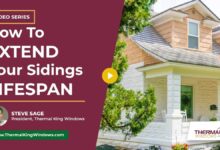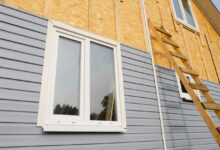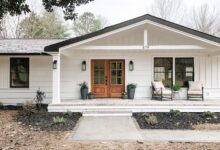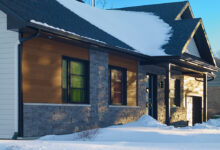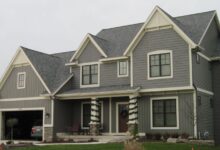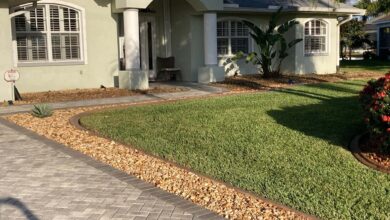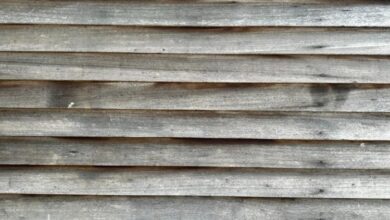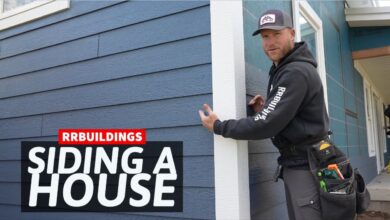Eco-Friendly Siding Materials for Homes
Eco-Friendly Siding Materials for Homes offer a compelling alternative to traditional siding, presenting a blend of environmental responsibility and aesthetic appeal. This exploration delves into the diverse range of sustainable options available, examining their properties, costs, and long-term benefits for both homeowners and the planet. From recycled materials to plant-based alternatives, we’ll uncover the advantages and considerations involved in choosing eco-conscious siding for your home.
The shift towards sustainable building practices is gaining momentum, and choosing eco-friendly siding is a significant step in reducing your home’s environmental footprint. This guide provides a comprehensive overview of the available materials, their performance characteristics, and the impact on energy efficiency and overall home value.
Introduction to Eco-Friendly Siding
Choosing eco-friendly siding for your home offers a blend of aesthetic appeal and environmental responsibility. It represents a conscious decision to minimize your home’s environmental footprint while still enjoying a beautiful and durable exterior. This shift towards sustainable building materials is gaining momentum as homeowners become more aware of the long-term impacts of their construction choices.
Eco-friendly siding materials are defined as those manufactured using sustainable resources and processes that minimize environmental harm throughout their lifecycle. This includes considerations from raw material sourcing and manufacturing to transportation, installation, and eventual disposal or recycling. Compared to traditional siding options, such as vinyl or certain types of wood, eco-friendly alternatives offer significant environmental benefits. They often require less energy to produce, generate fewer harmful emissions during manufacturing, and are more readily biodegradable or recyclable at the end of their lifespan. This contributes to reduced greenhouse gas emissions, less pollution, and a lower overall carbon footprint for your home.
Types of Eco-Friendly Siding Materials
Several sustainable materials are now readily available for use as eco-friendly siding. These options provide a variety of aesthetic choices while minimizing environmental impact.
- Recycled Materials: Siding made from recycled plastic, wood fiber, or other reclaimed materials offers a significant reduction in landfill waste and resource consumption. For example, siding made from recycled plastic bottles diverts waste from landfills and reduces the demand for virgin plastic production.
- Fiber Cement: This composite material combines cement, cellulose fibers, and other additives to create a durable and weather-resistant siding option. While its manufacturing process requires energy, fiber cement siding is generally considered more sustainable than vinyl due to its longer lifespan and lower maintenance requirements, resulting in reduced overall environmental impact over its lifetime.
- Bamboo: A rapidly renewable resource, bamboo siding offers a natural and aesthetically pleasing alternative. It requires minimal processing and grows quickly, making it a sustainable choice. However, it’s crucial to source bamboo from sustainably managed forests to ensure environmental responsibility.
- Reclaimed Wood: Using reclaimed wood for siding repurposes existing materials, diverting them from landfills and reducing the need for new timber harvesting. This option often presents unique aesthetic qualities due to the wood’s age and history, contributing to a home’s character and charm. Proper treatment and maintenance are crucial for ensuring its longevity.
Recycled Materials in Siding
The increasing demand for sustainable building materials has led to a surge in the use of recycled content in siding production. This not only reduces reliance on virgin resources but also offers a viable pathway to diverting waste from landfills. Several materials, notably recycled plastics and wood fibers, are finding increasing applications in eco-friendly siding options.
Recycled plastic, a readily available and cost-effective resource, offers a compelling alternative to traditional siding materials. Its inherent durability and resistance to various environmental factors make it a suitable choice for exterior cladding. Furthermore, utilizing recycled plastics contributes significantly to waste reduction initiatives.
Recycled Plastic Siding
Recycled plastic siding is often manufactured from a blend of post-consumer and post-industrial plastics. This mixture can include materials such as polyethylene (PE) and polypropylene (PP), chosen for their strength, weather resistance, and longevity. The manufacturing process typically involves melting and extruding the plastic into various profiles, mimicking the appearance of traditional wood or vinyl siding. The resulting product boasts considerable durability, often exceeding the lifespan of comparable wood siding while requiring minimal maintenance. Its resistance to rot, insect infestation, and moisture damage makes it a low-maintenance and long-lasting solution for homeowners seeking an environmentally responsible option. Some manufacturers even incorporate recycled content from ocean plastics, adding an additional layer of environmental benefit.
Recycled Wood Fiber Siding
Siding manufactured from recycled wood fiber presents another avenue for sustainable construction. This material is typically composed of reclaimed wood waste, such as sawdust, wood shavings, and other byproducts from the lumber industry. These fibers are often combined with binding agents and other additives to enhance strength, durability, and weather resistance. The resulting composite material offers a natural aesthetic, often mimicking the look and feel of traditional wood siding, while significantly reducing the environmental impact associated with harvesting virgin timber. The properties of recycled wood fiber siding can vary depending on the specific manufacturing process and the composition of the recycled materials. However, it generally exhibits good insulation properties, contributing to energy efficiency in homes.
Life Cycle Assessment of Recycled versus Virgin Material Siding
A comprehensive life cycle assessment (LCA) comparing recycled and virgin material siding reveals significant environmental advantages for recycled options. LCAs consider the entire lifecycle of a product, from raw material extraction and manufacturing to use, maintenance, and eventual disposal. Studies have shown that recycled siding generally has a lower carbon footprint compared to siding made from virgin materials. This reduction is attributed to several factors, including the lower energy consumption associated with recycling processes and the avoidance of deforestation or resource extraction. Furthermore, the reduced reliance on virgin materials minimizes the environmental impact associated with their harvesting and transportation. For instance, recycled plastic siding significantly reduces the demand for petroleum-based products, thus lowering greenhouse gas emissions. Similarly, recycled wood fiber siding decreases pressure on forests and reduces the amount of wood waste sent to landfills. While the initial cost of recycled siding might sometimes be slightly higher, the long-term environmental and economic benefits, including reduced maintenance and extended lifespan, often outweigh the initial investment.
Plant-Based Siding Options
Plant-based siding offers a sustainable alternative to traditional materials, reducing the environmental impact of home construction. These options utilize renewable resources and often boast lower embodied carbon footprints compared to their petroleum-based counterparts. Several plant-based materials are gaining popularity in the siding market, each with its own unique set of properties and manufacturing processes.
Types of Plant-Based Siding Materials and Manufacturing Processes
Several plant-based materials are suitable for siding. Bamboo, a rapidly renewable grass, is increasingly used due to its strength and aesthetic appeal. Fiber cement, while not solely plant-based, incorporates significant amounts of wood fibers, creating a composite material with improved durability and fire resistance.
Bamboo siding is typically manufactured by harvesting mature bamboo culms, treating them to prevent insect infestation and decay (often with borate solutions), and then cutting and shaping them into siding planks. These planks may be further processed to enhance durability and weather resistance, such as through heat treatment or the application of protective coatings.
Fiber cement siding production involves mixing Portland cement with cellulose fibers (often from recycled wood pulp), silica sand, and other additives. This mixture is then molded into the desired shapes and cured under controlled conditions to achieve the required strength and density. The resulting panels are durable, fire-resistant, and relatively low-maintenance.
Comparison of Plant-Based Siding Options
| Feature | Bamboo Siding | Fiber Cement Siding (with wood fiber) |
|---|---|---|
| Sustainability | Highly sustainable; rapidly renewable resource. | Moderately sustainable; utilizes recycled wood fibers and cement. |
| Durability | Moderate; susceptible to moisture damage if not properly treated. | High; resistant to rot, insects, and fire. |
| Maintenance | Requires regular maintenance, including sealing and occasional replacement. | Low maintenance; requires occasional cleaning. |
| Cost | Moderate to high; price varies depending on treatment and sourcing. | Moderate to high; generally more expensive than bamboo. |
| Appearance | Natural, warm aesthetic; various finishes available. | Smooth, consistent finish; various colors and textures available. |
| Installation | Relatively easy to install; similar to wood siding. | Requires professional installation; heavier and more difficult to handle than bamboo. |
Durability and Maintenance
Choosing eco-friendly siding doesn’t mean sacrificing durability. While the lifespan and maintenance needs vary across different materials, understanding these factors is crucial for making an informed decision. Proper maintenance can significantly extend the life of your siding, regardless of the material chosen.
The longevity and maintenance requirements of eco-friendly siding are influenced by several factors, including the material itself, the climate in which it’s installed, and the quality of installation. Exposure to harsh weather conditions like extreme temperatures, heavy rainfall, intense sunlight, and strong winds can accelerate the degradation of any siding material. Regular cleaning and occasional repairs are essential to maintain the appearance and structural integrity of your home’s exterior.
Lifespan and Maintenance Comparison of Eco-Friendly Siding Materials
Different eco-friendly siding options offer varying degrees of durability and require different maintenance schedules. For example, fiber cement siding, known for its strength and resistance to fire and insects, generally boasts a lifespan of 50 years or more with minimal maintenance. However, it may require occasional repainting to maintain its aesthetic appeal. On the other hand, recycled plastic siding, while durable and low-maintenance, might have a shorter lifespan compared to fiber cement, potentially lasting 20-30 years depending on the quality and UV protection. Plant-based siding, such as bamboo or reclaimed wood, often requires more frequent maintenance, including staining or sealing, to protect against moisture and insect damage. Their lifespan can vary greatly depending on the species of wood and the climate, potentially ranging from 15 to 30 years.
Impact of Weather Conditions on Eco-Friendly Siding Durability
Weather significantly impacts the durability of all siding materials, including eco-friendly options. Exposure to intense UV radiation from sunlight can cause fading and cracking in plant-based sidings and even some recycled plastic sidings. Heavy rainfall and snow can lead to moisture damage, especially in sidings with inadequate water resistance. Extreme temperature fluctuations can cause expansion and contraction, potentially leading to cracking or warping in some materials. Coastal areas with high salinity can accelerate corrosion in metal-based components of some composite sidings. Areas prone to strong winds might experience damage from impact or debris.
Maintenance Schedule for Common Eco-Friendly Siding Types
A regular maintenance schedule is key to prolonging the lifespan of your eco-friendly siding. The frequency and type of maintenance will vary depending on the specific material and climate.
Below is a suggested maintenance schedule:
| Siding Type | Annual Maintenance | Every 3-5 Years | Every 10 Years |
|---|---|---|---|
| Fiber Cement | Inspection for damage, cleaning with water and mild detergent | Repainting if necessary | Major repairs if needed |
| Recycled Plastic | Cleaning with water and mild detergent | Inspection for cracks or damage | Replacement of damaged sections |
| Bamboo | Cleaning, inspection for insect damage, re-sealing if necessary | Re-staining or re-sealing | Major repairs or replacement |
| Reclaimed Wood | Cleaning, inspection for insect damage, re-sealing if necessary | Re-staining or re-sealing | Major repairs or replacement |
Cost Comparison with Traditional Siding
Choosing eco-friendly siding often involves a careful consideration of upfront costs versus potential long-term savings. While initial investment might be higher in some cases, the total cost of ownership over the lifespan of your home can be significantly influenced by factors like maintenance, energy efficiency, and material durability. Let’s delve into a detailed cost comparison.
Cost Comparison Chart
The following chart provides a general price range for various siding materials. Remember that actual costs can vary widely depending on factors such as labor costs, geographic location, material quality, and project complexity. These figures represent average estimates and should be used as a starting point for your own research and budgeting.
| Siding Material | Price Range per Square Foot (USD) | Installation Cost per Square Foot (USD) | Total Estimated Cost (USD) |
|---|---|---|---|
| Vinyl Siding | $1-$4 | $2-$5 | $3-$9 per sq ft |
| Wood Siding (Cedar) | $3-$10 | $4-$8 | $7-$18 per sq ft |
| Fiber Cement Siding | $2-$7 | $4-$7 | $6-$14 per sq ft |
| Recycled Plastic Siding | $3-$6 | $4-$6 | $7-$12 per sq ft |
| Bamboo Siding | $4-$8 | $5-$8 | $9-$16 per sq ft |
Factors Influencing Installation Costs
Several key factors significantly impact the overall installation cost of any siding material, regardless of its eco-friendliness. These factors should be considered when comparing total project costs.
Labor costs represent a substantial portion of the overall expense. Highly skilled installers command higher rates, and complex projects with intricate detailing or extensive repairs will naturally increase labor hours and, consequently, the final cost. The accessibility of the house, requiring scaffolding or special equipment, can also inflate these costs.
Material preparation and waste disposal add to the overall expense. Some eco-friendly materials might require more intricate preparation before installation, which can influence labor time. Responsible disposal of construction waste is an additional cost factor.
Geographic location plays a crucial role. Labor rates and material availability vary regionally. Areas with higher labor costs or limited access to specific materials will result in higher overall project costs.
Potential Long-Term Cost Savings with Eco-Friendly Siding
While the initial investment in eco-friendly siding might be slightly higher in some cases, significant long-term cost savings are often realized.
Reduced maintenance requirements are a primary source of long-term savings. Many eco-friendly materials, such as fiber cement, require less frequent painting or staining compared to wood siding, resulting in considerable cost savings over the years. For instance, a wood siding home might need repainting every 5-7 years, while fiber cement could last 15-20 years before needing repainting.
Improved energy efficiency translates to lower utility bills. Certain eco-friendly siding options offer superior insulation properties, reducing energy consumption for heating and cooling. This leads to significant savings over the home’s lifespan. For example, a home with superior insulation might see a 15-20% reduction in energy costs annually.
Increased property value is another long-term benefit. Eco-conscious buyers increasingly value homes with sustainable features, potentially increasing the resale value of your property. This adds a significant financial advantage when compared to traditional materials that don’t offer the same environmental benefits.
Aesthetic Considerations
Choosing eco-friendly siding doesn’t mean sacrificing aesthetic appeal. In fact, many sustainable options offer a wide range of colors, textures, and styles that can enhance the curb appeal of any home, complementing various architectural designs and personal preferences. The key is understanding the options available and how they can contribute to the overall visual impact of your property.
Many eco-friendly siding materials can successfully integrate into diverse architectural styles. The versatility of these materials allows homeowners to maintain a consistent aesthetic while embracing sustainable building practices.
Architectural Style Compatibility
Eco-friendly siding, encompassing materials like recycled plastic lumber, fiber cement, and reclaimed wood, can complement a variety of architectural styles. For instance, the clean lines and modern aesthetic of fiber cement siding pair well with contemporary homes, while the rustic charm of reclaimed wood siding suits farmhouse or craftsman-style homes. Recycled plastic lumber, with its ability to mimic the look of traditional wood, can be adapted to numerous styles, offering a durable and sustainable alternative. The subtle textures and varied color palettes available further enhance this adaptability. A home with a traditional design could use reclaimed wood siding to highlight its historical charm, while a modern home might utilize fiber cement for its sleek and minimalist look.
Color and Texture Options
The range of colors and textures available in eco-friendly siding is surprisingly broad. Recycled plastic lumber can be manufactured in a wide array of colors, mimicking the look of natural wood with various stains and finishes. Fiber cement siding also offers a diverse color palette, often achieved through a durable paint process that resists fading and chipping. Plant-based sidings, such as those made from bamboo or sustainably harvested wood, provide natural variations in color and texture, adding a unique organic feel to a home’s exterior. These options extend beyond simple solid colors, incorporating subtle variations in shading and grain to create a more realistic and visually appealing surface. For example, a fiber cement board might be textured to resemble wood grain, while a recycled plastic option might be molded to replicate the look of stone.
Curb Appeal Impact
The choice of siding material significantly influences a home’s curb appeal. A well-chosen siding not only protects the house but also enhances its visual appeal, increasing its overall value. For example, a home with reclaimed wood siding projects a sense of warmth and character, while fiber cement siding offers a modern, clean look. Recycled plastic lumber, available in various textures and colors, provides a versatile option that can enhance the aesthetic appeal of various home styles. The use of eco-friendly materials, however, often communicates a commitment to sustainability, potentially attracting environmentally conscious buyers and increasing the home’s marketability. Consider a comparison: a home with dull, faded traditional vinyl siding versus one with freshly painted, textured fiber cement – the latter instantly projects a more modern and well-maintained image, boosting its curb appeal considerably.
Installation and Techniques
Proper installation is crucial for ensuring the longevity and effectiveness of eco-friendly siding. A well-installed system will protect your home from the elements, maintain its aesthetic appeal, and maximize the benefits of your chosen sustainable material. This section will detail the process of installing HardiePlank fiber cement siding, a popular and durable eco-friendly option.
HardiePlank installation requires careful planning and execution to achieve a watertight and aesthetically pleasing finish. The process involves several key steps, from preparation to final finishing, each requiring specific tools and techniques.
Tools and Equipment
The necessary tools and equipment for HardiePlank installation include a measuring tape, level, chalk line, circular saw with a fine-tooth blade specifically designed for fiber cement, safety glasses, hearing protection, work gloves, a hammer, nails appropriate for fiber cement, a nail gun (optional but recommended for efficiency), a utility knife, caulk gun, and weatherproof caulk. Additionally, scaffolding or a sturdy ladder may be needed depending on the height of the building. Proper safety gear is paramount throughout the installation process.
Step-by-Step Installation Guide
Before beginning, ensure the underlying structure is properly prepared. This includes inspecting and repairing any damaged sheathing or framing, ensuring it’s level and plumb. All necessary flashing and underlayment should be installed according to manufacturer specifications. This step is critical to prevent water damage and ensure a long-lasting installation.
- Starting the First Course: Begin at a corner of the house, establishing a straight, level baseline using a chalk line. The first course of siding is crucial for setting the alignment for the entire project.
- Attaching the Siding: Using the appropriate nails and nail gun (or hammer), fasten the HardiePlank to the sheathing, ensuring proper spacing and alignment with the chalk line. Nails should be driven straight and flush with the surface to prevent damage and ensure a clean look.
- Cutting and Fitting: Use the circular saw to accurately cut the siding to fit around windows, doors, and corners. Precision is key here to ensure a neat and professional finish.
- J-Channel and Corner Trim: Install J-channel and corner trim pieces to create a neat and weathertight transition between siding sections and around corners. These components are essential for preventing water intrusion.
- Caulking: Apply a high-quality, weatherproof caulk to seal all seams and joints, preventing water penetration. This is particularly important around windows, doors, and other areas where the siding meets other building components.
- Finishing: Once all siding is installed and caulked, inspect the entire installation for any gaps, misalignments, or other imperfections. Address any issues before moving on.
Best Practices for Watertight Installation
Proper flashing is essential. Install flashing around windows, doors, and other openings to divert water away from the siding and building envelope. Overlapping siding courses correctly, ensuring proper coverage and preventing water penetration. Using high-quality, weatherproof caulk to seal all seams and joints. Regularly inspect the siding for any signs of damage or water intrusion. Promptly addressing any issues will prevent larger, more costly problems down the line.
Impact on Energy Efficiency
Eco-friendly siding offers significant advantages in improving a home’s energy efficiency, leading to lower energy bills and a reduced carbon footprint. This enhanced efficiency stems from the materials’ inherent properties and their contribution to better insulation and air sealing.
The thermal performance of eco-friendly siding directly impacts a home’s ability to retain heat in winter and stay cool in summer. This translates to less strain on heating and cooling systems, resulting in substantial energy savings over the lifespan of the siding. The material’s ability to reflect or absorb solar radiation also plays a crucial role.
Insulation and Air Sealing
Effective insulation and air sealing are critical for maximizing energy savings with any type of siding, but particularly important when considering eco-friendly options. Properly installed eco-friendly siding can create a more effective barrier against heat transfer, reducing the amount of energy needed to maintain a comfortable indoor temperature. Air sealing prevents drafts and air infiltration, further minimizing energy loss. This is achieved through careful installation techniques and the use of appropriate sealants around windows and doors, ensuring a continuous and airtight exterior envelope. For example, fiber cement siding, when properly installed with appropriate flashing and caulking, can significantly reduce air leakage compared to older, less sealed siding.
Thermal Performance Comparison of Eco-Friendly Siding Materials
Different eco-friendly siding materials exhibit varying thermal performance characteristics. For instance, wood siding, while a natural and renewable resource, generally has lower insulation value compared to fiber cement or insulated vinyl siding. Fiber cement siding, due to its density and composition, offers better insulation than wood but may not match the performance of siding with integrated insulation. Insulated vinyl siding, incorporating a foam core, provides superior thermal resistance, leading to greater energy savings. However, the embodied carbon of the manufacturing process should also be considered when comparing the overall environmental impact. A comprehensive life cycle assessment would be needed for a complete comparison. For example, a study comparing the energy performance of a home with fiber cement siding versus traditional vinyl siding over a 20-year period might show a significant reduction in energy consumption with the fiber cement option, even considering its potentially higher initial cost. The specific savings would depend on factors such as climate, home size, and insulation levels in other building components.
Environmental Certifications and Standards
Choosing eco-friendly siding involves more than just selecting materials marketed as “green.” Understanding and verifying the environmental claims made by manufacturers is crucial for making truly sustainable choices. Reputable certifications and standards provide a framework for assessing the environmental impact of building materials throughout their lifecycle.
Verifying the environmental claims of siding manufacturers is essential to ensure that the products genuinely align with sustainability goals. Without independent verification, manufacturers’ claims may be misleading or lack sufficient evidence. Consumers should prioritize products with verifiable certifications to ensure the environmental benefits are legitimate and not merely marketing ploys.
Relevant Certifications and Standards for Eco-Friendly Building Materials
Several organizations offer certifications and standards that assess the environmental performance of building materials, including siding. These certifications consider factors such as the sourcing of raw materials, manufacturing processes, energy consumption, and end-of-life management. By looking for these certifications, consumers can make informed decisions about the environmental impact of their siding choices.
Examples of Reputable Certifications
- LEED (Leadership in Energy and Environmental Design): While not a specific siding certification, LEED is a widely recognized green building rating system. Siding materials contributing to a LEED-certified building often meet stringent environmental criteria.
- FSC (Forest Stewardship Council): This certification ensures that wood-based siding comes from responsibly managed forests that prioritize ecological sustainability. The FSC logo indicates that the wood has been harvested according to strict environmental and social standards.
- GreenGuard Gold Certification: This certification verifies that building materials, including siding, meet stringent standards for low chemical emissions, promoting better indoor air quality. This is particularly important for siding materials that might release volatile organic compounds (VOCs).
- Cradle to Cradle Certified™: This certification goes beyond simply minimizing negative environmental impacts. It evaluates materials based on their positive contributions to the environment and human health, encompassing material health, material reutilization, renewable energy, water stewardship, social fairness, and carbon management.
Future Trends in Eco-Friendly Siding
The field of eco-friendly siding is rapidly evolving, driven by increasing environmental awareness and advancements in material science. We can expect to see significant shifts in the types of materials used, the manufacturing processes employed, and the overall integration of sustainable siding into the construction industry. This section will explore some key emerging trends and their potential impact.
Innovation in sustainable siding is not just about finding new materials; it’s also about optimizing existing ones and developing more efficient manufacturing techniques. This includes reducing waste, minimizing energy consumption during production, and ensuring the longevity and recyclability of the final product. The future of eco-friendly siding hinges on the successful integration of these factors.
Emerging Sustainable Siding Materials
Several promising materials are poised to become increasingly prominent in the eco-friendly siding market. These include advancements in recycled plastic composites with improved durability and aesthetics, the development of bio-based polymers derived from renewable resources, and the continued refinement of fiber cement siding with reduced embodied carbon. For instance, research into using agricultural waste like rice husks or hemp fibers as reinforcing agents in composite siding is gaining traction, offering a truly sustainable alternative to traditional materials. Further, the development of more efficient recycling processes for plastic waste is leading to higher-quality recycled content in siding products, reducing reliance on virgin materials.
Improved Manufacturing Processes and Lifecycle Assessment
The focus is shifting towards minimizing the environmental impact of the entire lifecycle of eco-friendly siding, from raw material extraction to end-of-life management. This includes exploring closed-loop recycling systems, where materials can be recovered and reused repeatedly, reducing waste and reliance on new resources. Life cycle assessments (LCAs) are becoming increasingly crucial in evaluating the overall environmental performance of siding products, providing a comprehensive picture of their impact beyond just the raw materials. Companies are investing in LCA studies to transparently communicate the environmental benefits of their products and to drive further improvements in their sustainability profiles. For example, a company might highlight a reduced carbon footprint by using recycled materials and energy-efficient manufacturing processes.
Increased Adoption in the Construction Industry
The adoption of eco-friendly siding is expected to accelerate in the coming years, driven by several factors. Firstly, growing consumer demand for sustainable building materials is creating a strong market pull. Secondly, increasing government regulations and incentives are encouraging the use of green building products, including eco-friendly siding. Thirdly, advancements in technology are making eco-friendly siding more cost-competitive with traditional options. We can anticipate a gradual shift, with eco-friendly siding becoming increasingly prevalent in both residential and commercial construction projects. The growth of green building certifications like LEED is further incentivizing the use of sustainable materials, and we can expect this trend to continue, fostering a wider acceptance of eco-friendly siding within the construction industry.
Case Studies of Eco-Friendly Siding Projects
This section presents detailed accounts of successful projects employing eco-friendly siding materials, highlighting both the advantages and challenges encountered during implementation. These examples demonstrate the practical application of sustainable building practices and the tangible benefits they offer.
The Greenhaven Community Development
The Greenhaven Community Development project in Portland, Oregon, incorporated recycled plastic lumber siding on a series of affordable housing units. The project aimed to create durable, low-maintenance housing while minimizing environmental impact. The recycled plastic siding proved resistant to rot, insect infestation, and weathering, reducing long-term maintenance costs. However, the initial cost of the recycled material was slightly higher than traditional vinyl siding. The project successfully demonstrated the viability of recycled materials in large-scale housing developments, showcasing their long-term economic and environmental benefits, particularly in minimizing landfill waste. The visually appealing, dark grey siding blended well with the surrounding natural environment.
Sustainable Suburban Residence in Austin, Texas
A private residence in Austin, Texas, utilized fiber cement siding manufactured with a high percentage of recycled content. This project prioritized minimizing embodied carbon in the construction process. The fiber cement siding offered excellent durability and fire resistance, meeting the local building codes and homeowner’s requirements for longevity. A key challenge was finding a local supplier with readily available eco-friendly siding options that met the aesthetic preferences of the homeowner. This case study emphasizes the importance of considering both material sourcing and aesthetic appeal when choosing sustainable building materials. The light beige color of the siding complemented the home’s design and the surrounding landscape.
Commercial Building Renovation in Seattle, Washington
A commercial building renovation in Seattle, Washington, featured reclaimed wood siding sourced from deconstructed barns. This project highlighted the potential for repurposing existing materials to reduce waste and embodied carbon. The reclaimed wood siding, carefully treated to ensure durability and pest resistance, provided a unique aesthetic that reflected the building’s history and the surrounding urban environment. Challenges included the time-consuming process of sourcing and preparing the reclaimed wood, and the need for specialized installation techniques to ensure proper integration with the existing building structure. The project successfully showcased the potential of reclaimed wood siding in commercial applications, demonstrating its value in creating visually appealing and environmentally responsible buildings. The dark brown tones of the reclaimed wood siding added character and charm to the renovated building.
Epilogue
Ultimately, selecting eco-friendly siding for your home is an investment in both environmental stewardship and long-term value. By carefully considering the various options presented – their durability, aesthetic appeal, and cost-effectiveness – homeowners can make an informed decision that aligns with their personal values and contributes to a more sustainable future. The benefits extend beyond the immediate aesthetic improvements, encompassing energy savings, reduced environmental impact, and enhanced property value. Embracing eco-friendly siding is a responsible and rewarding choice for homeowners committed to responsible living.
